 Much has already been written and videoed about the Henry Repeating Arms AR-7 so I will not be able to add too much to the mix with one exception. Most, if not all, reviews and videos regarding the Henry AR-7 “Survival Rifle” have been presented from a right-hand shooter’s perspective. Although Jeff Quinn of Gunblast.com is a left-handed shooter, he did not mention any aspect of the AR-7 from that viewpoint. So, what you have here is the perspective from a cross-eye dominant, right handed person that shoots long guns weak side (left handed).
Much has already been written and videoed about the Henry Repeating Arms AR-7 so I will not be able to add too much to the mix with one exception. Most, if not all, reviews and videos regarding the Henry AR-7 “Survival Rifle” have been presented from a right-hand shooter’s perspective. Although Jeff Quinn of Gunblast.com is a left-handed shooter, he did not mention any aspect of the AR-7 from that viewpoint. So, what you have here is the perspective from a cross-eye dominant, right handed person that shoots long guns weak side (left handed).
THE BASICS:

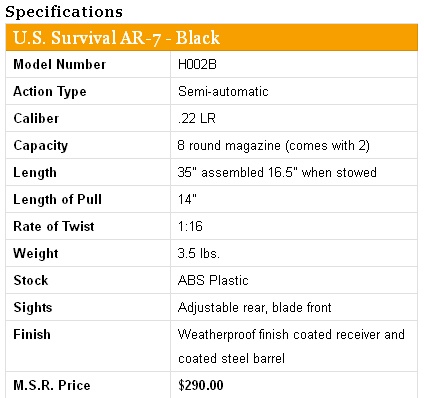
BUT, THERE IS MORE!
There are also articles and videos comparing the Henry AR-7 to various other firearms like the Ruger 10/22 Takedown, Marlin Papoose, and the original Armalite and Charter Arms AR-7. For giggles, we could also throw in the Ruger Charger or the Remington XP-100 bolt-action pistol (1963 – 1998). But, I simply need to expound on the pros and cons of the Henry AR-7 while letting it stand on its own merits (or demerits).
 First of all, let me start out by saying that the Henry AR-7 is a “chunky” piece. The stock is about 2.75 inches of ABS wide and needs to be wide to accommodate the action, barrel, and magazines (2 in the stock and 1 in the firearm, if desired) that reside within its interior in nicely formed slots to hold each component. The key features of the Henry AR-7 are portability and the ability to deploy it relatively quickly. At only 3.5 pounds in weight (without ammunition stored, and which the majority of the weight is due to the fully-assembled receiver) and 16.5 inches in length (components stored), I rate portability at 100%. Being able to deploy it quickly, with everyone being housed within the stock, is at about 75% when new, but does increase in percentage over use – due to the somewhat belligerent nature of the somewhat flexible butt cap during removal from the stock when new.
First of all, let me start out by saying that the Henry AR-7 is a “chunky” piece. The stock is about 2.75 inches of ABS wide and needs to be wide to accommodate the action, barrel, and magazines (2 in the stock and 1 in the firearm, if desired) that reside within its interior in nicely formed slots to hold each component. The key features of the Henry AR-7 are portability and the ability to deploy it relatively quickly. At only 3.5 pounds in weight (without ammunition stored, and which the majority of the weight is due to the fully-assembled receiver) and 16.5 inches in length (components stored), I rate portability at 100%. Being able to deploy it quickly, with everyone being housed within the stock, is at about 75% when new, but does increase in percentage over use – due to the somewhat belligerent nature of the somewhat flexible butt cap during removal from the stock when new.
One advantage of the stock that I find, where others may disagree, is the LOP of the stock. I prefer a stock on a long gun to be between 13.75 and 14.25 inches of LOP, and at 14 inches of LOP, the stock of the Henry falls right between my preference points. Some folks may find the LOP too long, to which all I can say that there is nothing that you can do about it with the Henry AR-7. Add some heavy or bulky outer wear to the mix, as would be during cold weather, you might find that pulling the trigger on the Henry AR-7 is a stretch.
One disadvantage of the stock is that it is ABS plastic, but it is a much needed improvement over previous version of the AR-7. This is not a firearm that you would care to leave in very bright and direct sunlight on a very bright and hot day unless, of course, you like to serve up a dish of warped stock. There have been cases of Glock pistols warping in direct sunlight when left on a vehicle’s dashboard and Glock polymer is way better than what we have here.
Yes, the components inside the stock do rattle. Thank you for asking.
There are a few precautions to take when removing components from the stock. Components should be pulled from the stock; they should not be just dumped out because damage to some of the components could occur. Henry recommends removing the receiver with the bolt handle facing up to prevent the possibility of loss. With that said, and with the charging handle properly installed, I don’t see it just falling out, because the bolt is actually stopped from moving forward (and out of the receiver) by spring tension against the charging handle, but I guess that anything is possible.
I have found that the easiest way to remove the butt cap (the proper term is “Stock Cap,” but I thought that I would have some fun here) is to support the stock, push the bottom of the butt cap slightly rearward to reveal a butt cap crack (no jokes, please) between the stock and the butt cap. Then, use the fingernails in the butt cap crack to pull the butt cap from the stock. I’ll let you play around with that one for a while.
The butt cap snaps into place when installing it on the stock. I have heard of some using Vaseline around the butt cap seal to add an additional layer of moisture-proofing. There is something about using Vaseline on a butt cap seal that doesn’t sit well with me. I’ll let you play with that statement as well.
Once the Stock Cap has been removed a couple of times, removal becomes easier.
The stock is set up for a right-handed shooter. The reason that I say that is that the stock, where it meets the left side of the receiver, is thicker than on the right side of the receiver. The barrel had to go somewhere in the stock and the left side was it, as the channel inside of the stock for the barrel is angled up and left. The stock is thick at the grip, which lend to the shooter simply placing the thumb over the stock rather than gripping it. I normally shoot with my thumb alongside the stock so it matters not to me. However, with the left side of the stock being thicker at the receiver than the right side of the stock, engaging the trigger with the shooting finger of my left (shooting) hand is not a challenge; I have somewhat long fingers. The upper left side of the stock makes a nice thumb rest. But, if a left-handed person has fingers of normal average length, then they should pick up and hold the rifle before making a decision to invest in the rifle.
The stock is well formed at the gripping part and definitely fills the hand. The hand feels more like it is cradling the firearm rather than gripping it. The stock is fully textured in what, I suppose, could be called a “granular” texture.
There is a “Patterning” of the stock at the top of the grip area. I would have liked to seen this carried beneath the grip area for a better grip during wet weather or when handling with sweaty hands. I can see some sort of grip tape being used behind the trigger; some free cut “Talon” rubberized grip material or a strip of skateboard tape, perhaps, might work here with a very, very mild application of heat for adhesions purposes. The stock is ABS after all; heat and ABS usually do not mix well.
The operation of the “Yuge” safety lever, which is located on the right rear of the receiver, is a challenge to use as a “lefty” because of the wide stock. Because my right had is my “working” hand, I use the thumb of the right hand to manipulate the safety since it is in close proximity to it when supporting the rifle, which leads to the next thing – supporting the rifle.
As a left-handed long gun shooter I, of course, support the long gun with my right hand. This can cause some issues with some long guns depending on where I support the long gun. With a MSR, there are no issues when supporting the firearm in “CQB Mode” where the hand is wrapped around the magazine housing. I have, occasion, placed the thumb of my support (right) hand in the pathway of the bolt handle of an AK, and I am reminded (reminding involves pain more often than not) very quickly to keep my thumb forward of a bolt handle that slams rearward at a high rate of speed.
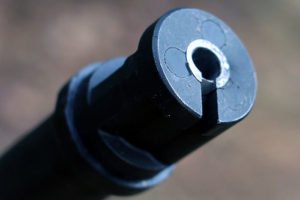
The Chamber Face. Note the Lack of a Feed Ramp. Feeding is a Magazine’s Job!
The feed ramp of the Henry AR-7 is part of the magazine. So, you don’t want to apply pressure to the magazine, which could cause mis-feeds. It is not like there is a heavy barrel to support on the Henry AR-7 and my solution is to simply hold my support hand around my shooting hand at the grip. This technique is the same used when firing a Colt Revolving Rifle where you don’t want the support hand anywhere near the “Flash Gap” of the cylinder. While no serious damage to the thumb would occur if it happened to get behind the bolt handle, it is without a doubt that the action would fail to cycle properly.
From a “lefty” point of view, the right (support) hand can be moved up slightly for the thumb to operate the safety lever, or can be moved under the magazine as the left hand operates the magazine release lever that is located at the front of the trigger guard. By the way, magazines exit the Henry AR-7 very well and need to be caught to prevent them from dropping against a hard surface, which could possibly damage them.
My “alternative” hold is to wrap the first, otherwise technically known as the “trigger finger,” and middle finger of my right hand around the magazine housing with the thumb planted against the receiver just below the spent cartridge egress; otherwise known as the ejection port. Unfortunately, this places my thumb in very close proximity to ejected shell casing and hot escaping gases.
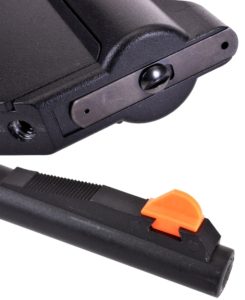 The rear sight aperture comes in two sizes; small 0.(2mm or ≈0787”) and smaller (1mm or ≈0.0394”). A simple flat head screw provides the means to adjust the rear sight for elevation (within limits) and swap it over (literally) for the other aperture. A rail is provided, on the newer models of the AR-7, which allows you to mount an optic that, of course, detracts from the stowing capabilities. The slotted rail is just a glorified 3/8” dovetail mount. If I had the propensity to mount an optic for survival purposes, the optic would have to be as compact and light as possible, a fixed magnification, quickly detachable/attachable, and batteries would not need to be included. Weaver does make a T-22 mount that will adapt a 3/8” dovetail receiver into a Weaver sight base. I will have a review of the T-22 Weaver adapter in a separate article.
The rear sight aperture comes in two sizes; small 0.(2mm or ≈0787”) and smaller (1mm or ≈0.0394”). A simple flat head screw provides the means to adjust the rear sight for elevation (within limits) and swap it over (literally) for the other aperture. A rail is provided, on the newer models of the AR-7, which allows you to mount an optic that, of course, detracts from the stowing capabilities. The slotted rail is just a glorified 3/8” dovetail mount. If I had the propensity to mount an optic for survival purposes, the optic would have to be as compact and light as possible, a fixed magnification, quickly detachable/attachable, and batteries would not need to be included. Weaver does make a T-22 mount that will adapt a 3/8” dovetail receiver into a Weaver sight base. I will have a review of the T-22 Weaver adapter in a separate article.
The front sight, which seems to be a blaze orange bit of polymer, is adequate in most cases, but can wash out in bright sunlight. At an indoor range or when in the woods, the front sight pops very well. I may be taking a cue from Jeff at Gunblast.com and enlarging the largest of the rear sight apertures to 1/8 inch due to my aging eyes. With that said, I found that the rear sight works with my eyes. Only more time behind the rear sight will tell.
It should be noted here that if you find that you are shooting left or right from POA, the plastic front sight blade can be pushed within its dove-tail groove by simple thumb pressure. It is recommended that once the front sight is properly positioned, a thin application of clear fingernail polish be applied, and left to dry, on each side of the plastic front sight base; this will help to prevent front sight movement in the future.
The cast aluminum receiver and steel barrel are well-protected from the elements due to the Teflon coating each has received. The finish on the receiver is also slightly textured, which makes handling the receiver during assembly and disassembly not a slippery proposition. The barrel is an ABS plastic steel lined barrel coated in Teflon for complete protection from the elements.
The left side plate of the receiver can be removed to access the trigger components, although I would recommend that if you are not comfortable in working with the inner sanctum of the receiver, it is best to let only a qualified and competent armorer be in that area.
A LITTLE LESS TALK; A LITTLE MORE ACTION:
 Trigger pull weight on my particular unit is ≈4.5 pounds on average. The trigger is gritty when new and exhibits a slight, but gritty, amount of take-up. The only purpose of the trigger is to release the internal hammer. Yes, the AR-7 is a hammer-fired firearm and the hammer does a fine job in doing so.
Trigger pull weight on my particular unit is ≈4.5 pounds on average. The trigger is gritty when new and exhibits a slight, but gritty, amount of take-up. The only purpose of the trigger is to release the internal hammer. Yes, the AR-7 is a hammer-fired firearm and the hammer does a fine job in doing so.
The action is a pretty simple affair, actually. A dual-lever spring determines trigger pull weight and hammer force. Perhaps a bit of polishing might smooth the action up a bit, but my inclination is to let this one wear in naturally. The Eugene Stoner design for a trigger has not changed in the AR-7 and probably served as the forerunner of future AR trigger. The face of the trigger lever itself is thin, which has drawn some complaints from some AR-7 users. However, the AR-7 is not a firearm that I would be taking to the range on a regular basis, but I would exercise it occasionally. The trigger pull is actually comparable to that on a MSR with a standard MIL-SPEC trigger. In fact, with my particular AR-7, the trigger pull weight was less than that found with the two MSRs that I own when new. The question is, how well will the trigger break in? I can’t answer that question, and considering that the AR-7 has always been considered a “Survival Rifle,” the trigger is acceptable given the original intent of the firearm, in my opinion.
I should interject an important (I think) note here regarding the firing pin. The firing pin is a free-floating affair; there is no spring tension on the firing pin to retract it back into the bolt. For this reason, the bolt should be meticulously cleaned after, and maybe during, each range session. This meticulous cleaning may prevent a “slam fire” from occurring. It is important to keep the firing pin “free floating” to reduce the possibility of a “slam fire.” On a side note, I use Brākleen® (non-chlorinated) to thoroughly clean the bolts on my semi-automatic and bolt-action rifles.
Also, and because of the lack of a firing pin return spring, it is advised to refrain from “dry firing” the AR-7 unless you have a snap-cap or expended casing in the chamber to stop the forward motion of the firing pin when struck by the hammer. Although there is a firing pin retaining pin, which prevents the firing pin from moving too far past the face of the bolt, excessive dry-firing could cause damage to the retaining pin or the firing pin itself let alone to the breech face. Unfortunately, the bolt does not lock back on the last round fired; some “dry firing” is inevitable after the last round in the magazine is fired. Counting the number of shots fired should be on your list of priorities when shooting the AR-7. Of course, this is true with many rimfire rifles.
The charging handle is unique in that you can push it inward when it is not needed and simply pull it outward when it is needed. During normal operation, the charging handle usually finds its way inward and needs to be plucked out to chamber a fresh round from a new magazine.
I have found an extended charging handle that leaves enough “handle” to operate without having to pull the charging handle out. However, using such negates the capability of returning the receiver back into the stock for storage.
RUNNING SPARES:
While most gun reviewers talk about the here and now regarding a firearm, most will not mention anything about the firearm years down the road or how that firearm will be after thousands of rounds are fired through it. Obviously, that would be speculation on their part. For my part, I want a few spare parts on hand that I would consider susceptible to wear and tear or loss. For that reason, I was going to order a few parts from Henry to have on hand; my “running spares,” as I call them.
For the AR-7, and aside from magazines, these parts consisted of the following:
- Charging Handle (in case of loss)
- Action Springs (a set of two)
- Action Spring Guide (a plastic unit that is susceptible to damage and/or wear, IMHO)
At this point, I am going to give Henry Customer Service a well-deserved shout-out. I had e-mailed Henry Repeating Arms Customer Service in regards to ordering the aforementioned parts, since there is no provision for ordering parts (with the exception of magazines) through their web site. Within an hour of sending my e-mail, I received an e-mail from Catherine Scarpa, a Customer Service representative of Henry, who not only thanked me for owning a Henry AR-7 but offered to send me the parts free of charge. Since I had already provided the serial number, I just needed to provide my shipping address. That was something that I did not expect at all. This type of customer service tells me that the folks at Henry Repeating Arms not only care about their products, but more importantly, they care about their customers. Within three days, the parts were in my hands and are ready for use when I need them.
With this in mind, I also would like a spare ejector, which is a thin looking unit that would seem susceptible to damage. But, I’ll save that for later.
ON ORDERING SPARE MAGAZINES:
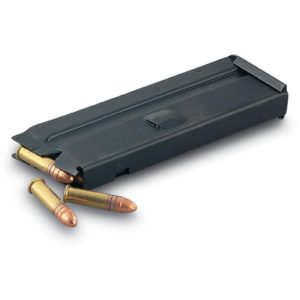 While the provided two 8-round magazines that are shipped with the AR-7 do keep the propensity down for shooting extremely long strings of fire, they do fit with the theme of the rifle, and they do fit in the stock of the rifle.
While the provided two 8-round magazines that are shipped with the AR-7 do keep the propensity down for shooting extremely long strings of fire, they do fit with the theme of the rifle, and they do fit in the stock of the rifle.
Although two 8-round magazines come with the AR-7, we all know the benefit of having more magazines than most manufacturers provide with their firearms. In the case of the AR-7, there are (at least) three versions of the AR-7; the Armalite version, the Charter Arms version, and the Henry Repeating Arms version. What is important is that you order the magazines for your particular version of the AR-7, as there are differences in magazines for each of these versions. I have heard that the magazines for the Henry repeating Arms version will work in previous versions, I cannot attest to that. Heck, the magazines provided with previous version would not work in their intended rifles; having a magazine that works in all previous versions is a big step-up in anybody’s book.
I found “used” magazines for the AR-7 at The Sportsman’s Guide at a reasonable cost. I ordered several, based on positive comments from previous purchasers, to try in the Henry AR-7. I have also ordered magazines that are specific to the Henry AR-7 through Cheaper Thank Dirt.
When they arrived, I compared each magazine to the magazines that originally came with the Henry AR-7. Four magazines were from The Sportsman’s Guide. Each magazine was individually wrapped in plastic and labeled as magazine specifically for the Henry AR-7 and, in fact, carried an HRAC (Henry Repeating Arm Company) number and UPC. I suspect that these may have been magazines used for AR-7 testing at the factory. Inspection of each magazine revealed no differences from that originally delivered with the AR-7. The magazines received from Cheaper Than Dirt were also specifically marked for the Henry AR-7. Like the magazines from The Sportsman’s Guide, these were identical to the magazines received with the rifle. Only use will tell of any problems.
RANGE TIME:
I wanted to run different cartridges from different manufactures through the AR-7 for the first range session. My selection ammunition was CCI Mini-Mag (40-grain CPHP @ 1235fps) and Remington “Thunderbolt” 40-grain LRN (1255fps). To eliminate possible magazine malfunctions using multiple magazines, I ran all ammunition through the same magazine.
I wanted to use the open sights that came with the rifle to see how accurate I could be with those sights once I had my “zero” as close as possible with those sights.
CAUTION!
Always clear AR-7 malfunctions with the muzzle pointed down and the magazine removed from the firearm. When the muzzle is pointed up, there is enough of an opening between the bolt and the receiver to drop a live round or expended cartridge case into the trigger mechanism, which requires careful shaking to get it out of the action; that process works best with the barrel removed.
I ran though a magazine of eight rounds at ten yards for familiarization. Initially, the AR-7 was shooting slightly right, and a little push of the front sight to the right with my thumb brought impact more to center. Elevation was matter of figuring out where on the target I needed to sight. As it turned out, if I placed the top of the front sight right on the top of my intended POA, the rounds were hitting as close to the center as I could get them.
A new 100 yard sight-in target was set at 15 yards distant. The target that I was using would give me a 1″ orange bulls-eye to focus on while viewing the target through the factory sight, which was actually a poor choice of targets given the orange front sight of the AR-7.
During the entire course of fire (about 40 rounds, I had one Remington cartridge choke on me; a failure to feed that totally destroyed the cartridge. The following shows the two best groups at fifteen yards with the provided sights.

Not Bad Grouping Once I Figured Out Where to Aim
The low hits were a result of placing the front sight in the center of the bulls-eye. Placing the top of the front sight at the top of the bulls-eye resulted in the subsequent shots.
Surprisingly, the trigger, although heavy, is very controllable. The rear sight is adequate, but the long of pull of the stock, combined with the width of the stock, made shooting quite a challenge. I could see mounting an optic with a medium eye-relief would definitely help the shooter, and I plan to just do that very thing. The challenge is getting a scope mounted low enough but yet clearing the rear sight housing that is about 0.358” above the flat of the mounting base of the AR-7. Putting an optic on the AR-7 is going to be a challenge that I will address when that project is completed. For now, it is time to do research and crunch numbers.
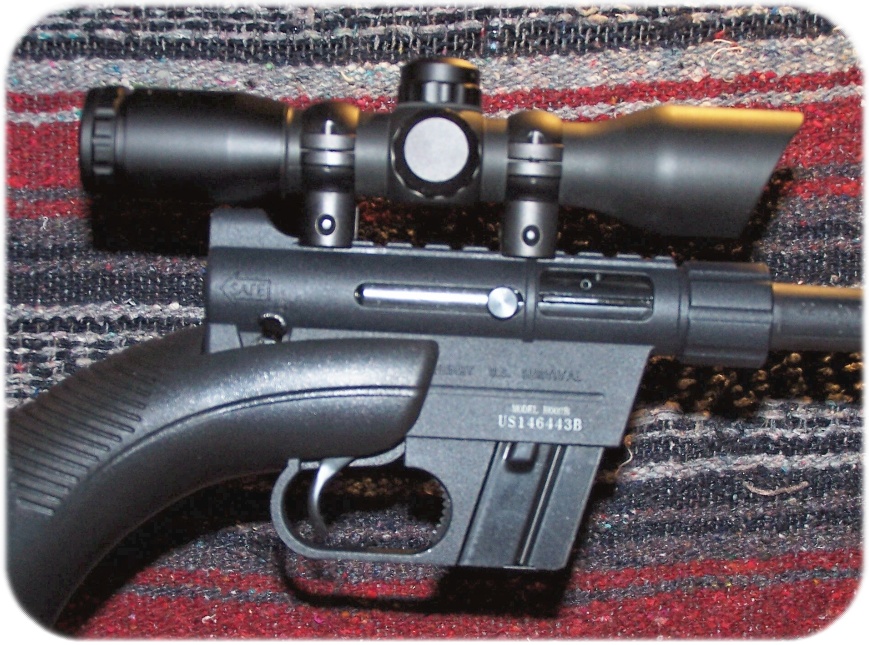
Experiment With Scoping the Henry AR-7
I will say that the ABS stock seems to amplify the sound of the trigger resetting. The trigger reset, by the way, is almost at the end of the forward travel of the trigger.
ALTERNATE SAFE STORAGE SOLUTION:
While the AR-7 comes in its own small cardboard box, and some may store the AR-7 in the box and in a safe, may I suggest an alternate safe storage means?
It just so happens that the Henry AR-7, when disassembled, fits nicely in a Bore Stores P9 Scope 14″ Contender; 9×19 silicon treated gun storage mitt. The Bore Store protects the Henry AR-7 from the bumps and scrapes that it might encounter when sharing space with other firearms, and keeps it from the effects of humidity.
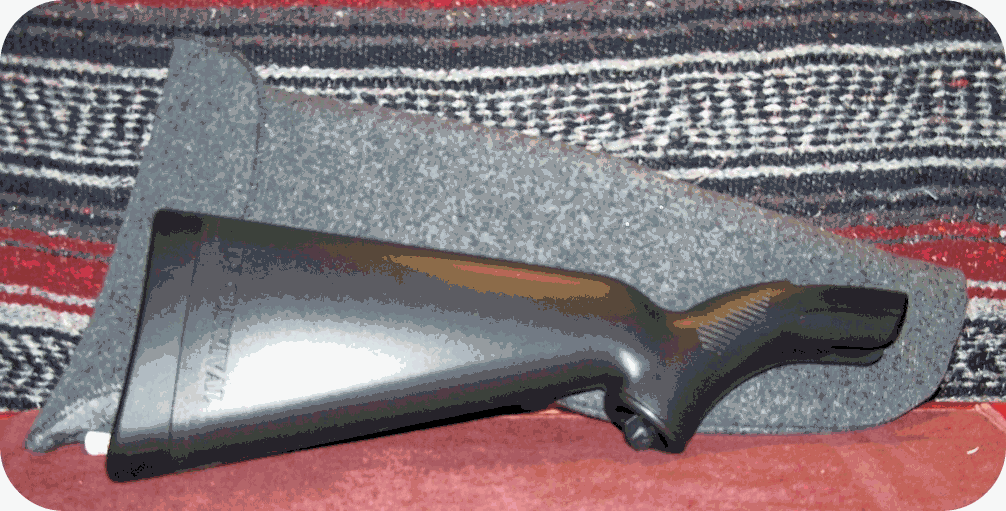
Bore Store P-9 SCOPED 14″ CONTENDER; 9″ x 19″
FINALLY:
Where does the Henry AR-7 Survival Rifle fit in? There are still plenty of older models still around from Armalite and Charter Arms, even in the form of a pistol (Charter Arms Explorer II Pistol). AR-7 Industries make solid steel barrels much heavier than the AR-7 barrels by Armalite, Charter or Henry, along with serving as a source for virtually every part for the AR-7. It is not a rifle that would be destined to shoot as often as possible. In fact, once zeroed and packaged, it is highly likely that the Henry AR-7 might find its way into a GHB or BOB with a hundred rounds of ammunition – just in case. It could be a good companion for camping, hiking, or boating, but I suspect that shooters would prefer something more like the Ruger 10/22 Takedown, or even a Ruger Charger due to the ruggedness and reliability of these firearms. The AR-7 is an oddity, but a good oddity. The AR-7 is one of those firearms that is nice to have, whether you need one or not.
Since Henry Repeating Arms has stepped out with the AR-7, the quality has definitely improved over those manufactured by earlier companies.
While not ideally suited for left-handed operation, due to the offset and width of the stock on the left side, I did not find it bothersome. This is not a firearm that I am going to be shooting on a regular basis, unless I get into heated competition with another AR-7 owner.
The Henry AR-7, in its “packed” form, is highly transportable. In fact, it fits perfectly in my Maxpedition Operator Tactical Attaché bag (http://www.maxpedition.com/store/pc/Operator-Tactical-Attache-Medium-113p70.htmg) that once served me in the corporate world and now serves me in the shooting world.
To close this up, I like the Henry AR-7. It seems to be growing on me. More often than not I am shooting firearms that are intended for serious work but can be used for just plinking. In this case, I am shooting a fun plinking tool that can be used for serious work. Funny, how that works out.
After working with the AR-7 for a short time, I can see that the AR-7, whether manufactured by Armalite, Charter Arms, or Henry Repeating Rifles might have a “cult” following of sorts. The Stoner-based AR-7 is just a hoot to shoot.
The Henry AR-7 is just one of those firearms that beg to be upgraded. However, with the cost of the firearm as it is, it can be one heck of a decision to spend additional funds to upgrade it. That is something that I had to decide, and if you own one of these, or are thinking about owning one of these, will the investment going to be worth the return. Some may think about this in a financial sense, and for some that does makes sense. To me, and if I was to use the AR-7 as a true “Survival” rifle, then I want the best upgrades that I can afford for it because my survival just may be at stake with this firearm.
For me, I like options. The more options that I have, the better I like it.
The Henry AR-7 is just one of three popular take down firearms in .22 long-rifle caliber. All three have their own issues. Of the three, I have two; the Henry AR-7 and the Ruger 10/22 Takedown. Of those two, the Ruger 10/22 Takedown is by far the easier to add a magnified optic. The AR-7 is just a unique firearm with a unique history.
Of course, there is also the Ruger Charger that is highly portable, can be fitted with a bipod, a magnified pistol optic, uses any of the Ruger magazines, is fully be customized to your needs and wants, is accurate enough for most situations, and can be had in bull-barreled and take down configurations. My Ruger Charger resides in its original case with two BX-25 magazines, ammunition, and a spare BX-trigger (just in case). Throw in a handful of Slim Jim snacks and I am good to go.
And, on a final note, a long Slim-Jim snack can indeed be stored in the stock of the AR-7 when the barrel is removed, as suggested by my shooting companion, Mike. I knew that question was on your mind and I thought that I would answer it. As Jeff Quinn at Gunblast.com illustrated, other snacks, a small first-aid kit, or other “survival” items could also be stored in the stock when the AR-7 is assembled.
So, there you have it; the Henry AR-7 U.S. Survival Rifle from my point of view. Can you live without the Henry AR-7 U.S. Survival Rifle? Probably, yes! But, one of my favorite sayings is; “I worked hard for it, I deserve it, and why should anybody deprive me of it!” It is an enjoyable, compact carbine that you would enjoy shooting on occasion, or if needed, a good survival tool.
Author’s Note: Read an article about placing an optic on the Henry AR-7: Optics and the Henry AR-7 U.S. Survival Rifle Is the Challenge Worth It?: https://guntoters.com/blog/2017/03/20/optics-and-the-henry-ar-7-u-s-survival-rifle/
UPDATE 03/31/2017:
As I mentioned in the article, the rear sight aperture comes in two sizes; small 0.(2mm or ≈0.0787”) and smaller (1mm or ≈0.0394”). Given the LOP of the stock, and my old eyes, I took a bit of information from Jeff Quinn at Gunblast.com and drilled out the larger of the apertures to 0.125 inches (1/8″); an increase of 0.363 inches over the stock aperture. What a difference that made!
The rear sight aperture is now more like a true “ghost ring” sight that gives me a wider field of view of the target and quicker front sight acquisition. I find it much easier to use over the standard aperture.
Plans are in the mill to improve on the magnified optic for the AR-7. I am simply not satisfied with the large package that was chosen in the AR-7 optics competition. Once the optic is finalized, I’ll update the Optics and the Henry AR-7 U.S. Survival Rifle Is the Challenge Worth It?: https://guntoters.com/blog/2017/03/20/optics-and-the-henry-ar-7-u-s-survival-rifle/ article.
THOSE OTHER PRODUCT REVIEWS:
Video reviews, from Hickok45 and SOOTCH00, can be found at Henry’s web site: https://www.henryusa.com/rifles/u-s-survival-ar-7/
And, American Rifleman has: The Unlikely Resilience of the AR-7 Survival Rifle: https://www.americanrifleman.org/articles/2016/12/27/the-unlikely-resilience-of-the-ar-7-survival-rifle/
A search of the WWW can yield many more video reviews than I can list here.
RESOURCES:
- U.S. Survival AR-7 Rifle: https://www.henryusa.com/rifles/u-s-survival-ar-7/
- AR-7 Parts: https://www.ar-7.com/AR7Parts.html
- Bore Store P-9 Scoped 14: http://www.borestores.com/order_online.php?cam=product_details&prod_id=5082
![]()

